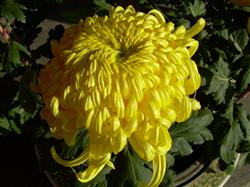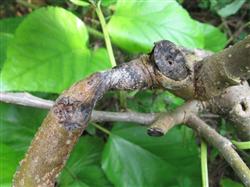Control of pseudotail brown spot of chrysanthemum

The main results are as follows: 1. the symptom spot is born on both sides of the leaf, nearly round, the initial edge is not obvious, and then it sometimes produces a dark brown thin coil, often growing along the edge of the leaf. The foliar disease spot is light yellow at the beginning, brown to dark brown in the later stage, and grayish brown on the back of the leaf. 2. the disease is caused by fungi, and the pathogen is pseudocercospora chrysanthemum. The pathogen overwintered on the diseased body, carried out primary infection and re-infection with conidia, and spread by airflow and Rain Water sputtering. It is easy to get sick in rainy or foggy weather. 3. Prevention and control methods (1) Horticultural control: combine picking leaves to collect diseased bodies and take them out of the field to burn; clear ditches and drain water, avoid partial application of nitrogen fertilizer, make plants grow healthily and enhance resistance. (2) Chemical control: at the initial stage of the disease, 50% propofol wettable powder was sprayed 1000 to 1500 times, 50% carbendazim wettable powder 500 times per mu, 100 ml root irrigation per plant, once every 7 to 10 days, two or three times; with 75% chlorothalonil wettable powder 147 grams per mu, 75 liters of water, evenly sprayed.
- Prev

Cultivation and Management of Yellow Chrysanthemum
Yellow chrysanthemum is called chrysanthemum cauliflower. The leaf of chrysanthemum cauliflower plant is round, the petiole is shortened and many wheels form a chrysanthemum shape, the petiole is green, the leaf is glossy, the leaf edge is entire, the weight of single plant can reach 150 grams, the quality is good, and the flavor is better after frost. Chrysanthemum cauliflower has the effect of clearing heat, dispelling wind, detoxification and eyesight. Many friends ask about it.
- Next

Removing Mulberry Flowers and Mulberry fruits to Control Mulberry shoot Breaking Disease
Mulberry shoot-breaking disease, also known as branch-breaking disease, white mulberry disease. Shoot-breaking disease is a widely prevalent mulberry disease in recent years. It is a disease caused by the pathogen of Sclerotinia sclerotiorum to infect new shoots through the stalk of morula, causing the base of new shoots to rot and break. The disease is characterized by the disease of mulberry trees with long female mulberry flowers or androgynous flowers.
Related
- Fuxing push coffee new agricultural production and marketing class: lack of small-scale processing plants
- Jujube rice field leisure farm deep ploughing Yilan for five years to create a space for organic food and play
- Nongyu Farm-A trial of organic papaya for brave women with advanced technology
- Four points for attention in the prevention and control of diseases and insect pests of edible fungi
- How to add nutrient solution to Edible Fungi
- Is there any good way to control edible fungus mites?
- Open Inoculation Technology of Edible Fungi
- Is there any clever way to use fertilizer for edible fungus in winter?
- What agents are used to kill the pathogens of edible fungi in the mushroom shed?
- Rapid drying of Edible Fungi

